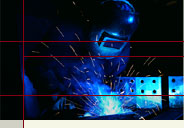
EGR stands for Exhaust Gas Return. The EGR is a federally mandated system designed to control tailpipe exhaust emissions. The EGR accomplishes this along with the main catalytic converters, and by Electronic Control Unit (ECU) adjustments to the engine. Now would be a good time to review this site's Disclaimer.

The EGR system reduces emissions by returning small amounts of metered exhaust gases back to the engine intake. The theory is that by using exhaust gas as part of the intake air/fuel mixture, there is less oxygen to burn, which lowers the temperature of combustion. Cooler cylinder head temps lead to less formation of pollutants, specifically nitrogen oxide (NOx) compounds.
Also, anytime exhaust gas is being re-burned, that amount of "clean" atmosphere is being saved, although this pollution reduction by the EGR is considered small compared to the overall reduction in NOx. If the EGR sounds like a compromise to engine performance, then you are right. Engines were not designed to run on spent exhaust gases. That is one of the reasons that the EGR is not operational when the engine is cold or needs full power.

I am a proponent of simplifying the engine bay of the Z whenever possible. The EGR is left well enough alone as long as it's working properly. The problem is that a malfuctioning EGR can be nearly impossible to fix with the engine still in the car. An old leaky EGR that allows exhaust gases into the upper intake plenum at the wrong time could be damaging to the engine. Pulling the engine just to fix the EGR would be labor and cost prohibitive for many people. So when the engine is out of the car for whatever reason, that would be the time to seriously consider removing the EGR. My engine was pulled to install new turbochargers. After an EGR delete, an upper plenum pull goes from being a knuckle-buster to a walk in the park.
There are better mechanics than me who tell me they have gotten their EGR's out with a just an upper plenum pull. To get to the EGR bolt that threads into the drivers side exhaust manifold the brake booster has to come out. There are better mechanics still that tell me it is not worth the effort unless the engine is out of the car.

In theory, can a Z pass emissions without an EGR? We don't have "sniffer" tests where I live, so my info on this is second hand, but I consider it reliable. The answer is yes, usually no problem. Most of the "work" done to reduce tailpipe emissions is accomplished by the main catalytic converters (cats), and we will assume those remained in place and are functional. I run "high-flow" cats on my car. Recall that a stock twin turbo also has two smaller "pre-cats" bolted up to the turbos.
Z's have passed the strictest emissions tests without EGR's. I would make sure your car could pass emissions testing before the EGR was deleted. If an inspector knows what to look for, the car will flunk a visual inspection without an EGR. The EGR is well hidden under the hood and cannot be seen upon casual inspection. The EGR is on the back of the engine, in the middle, facing the firewall. The metal tubes feeding the exhaust to the engine are connected to the underside of the upper plenum. That is one good reason why NOT to take your Z to the dealer for an inspection. Go to "Joe's Garage" on the corner that doesn't get to work on Z's every day.
Z's with a California spec ECU, as well as '95 and '96 Z's have a temperature sensor plugged into the base of the EGR. Disconnecting this sensor as part of the EGR delete will cause the CEL (check engine light) to come on. This will keep the car from passing emissions. I am told by peeps who know a lot more about this than me that replacing the temperature sensor at the EGR with a 68K ohm resistor will fix this problem and keep the CEL off.
Recall that it is a federal violation to tamper with any vehicle's emissions system. But in theory, if a car passed emissions without an EGR, then that car is still meeting federally mandated pollution standards.

Does it "hurt" the engine to delete the EGR? This question pops up when folks start trying to understand and analyze how the EGR works. Here is my take on it. The EGR control valve regulates the quantity of exhaust gas that is diverted or "returned" to the intake plenum. The EGR is vacuum operated and connected to the ECU by a solenoid.
This next part gets a little confusing. The conditions under which the EGR normally functions LOWERS the cylinder head temperatures. Even though the exhaust gases are VERY HOT, on the order of 1000-1500 degrees Fahrenheit, they are relatively inert compared to normal atmosphere. The exhaust gases have already been combusted and therefore contain less oxygen. Plus, even the exhaust gases are still cooler than the temperatures in the combustion chambers. The exhaust gases are returned to the cylinders by the EGR for combustion, but since they contain less oxygen, these gases do not burn as hot. This is how the emissions are reduced, by running part of the exhaust gases thru the engine again and again, which lowers the cylinder head temperature.
Now consider the conditions, according to the factory service manual, under which the EGR is NOT diverting the exhaust gases into the intake plenum.
1) Low engine temperature
2) Engine starting
3) High-speed engine operation
4) Engine idling
5) Excessively high engine temperature
The EGR is designed to be mainly operational when the engine is cruising and already warmed up. Removing the EGR should not put the engine under increased risk. The EGR is only working when the engine is under minimal stress. Pay particular attention to numbers 3 and 5 above. Anytime the engine is under a significant load or stress, the EGR is NOT functional. The times when the engine would be at greatest risk for detonation with the highest cylinder head temperatures, the engine is already operating without the EGR. Therefore, deleting the EGR should have no impact on these conditions.
Given the age of our cars, I feel the greater risk would occur from leaving an old EGR in place. EGR's get gummed up and sticky over the years. If an EGR leaked and allowed exhaust gases into the intake plenum at the wrong time, such as at wide open throttle, THEN the car could be at risk for catastrophic detonation. A malfunctioning EGR is a known cause for engine detonation in any engine, not just the Z.
When a Z engine does suffer catastrophic engine failure due to detonation, the immediate preceding event often goes unproven and unknown, especially if that engine has been modified and is running higher boost pressure. No one knows what role, if any, old EGR's have contributed to this. My point is that from a safety standpoint, I would argue that the car is safer and the engine more stable WITHOUT the EGR. I have never heard of one Z car suffering detonation or performance issues after an EGR delete.
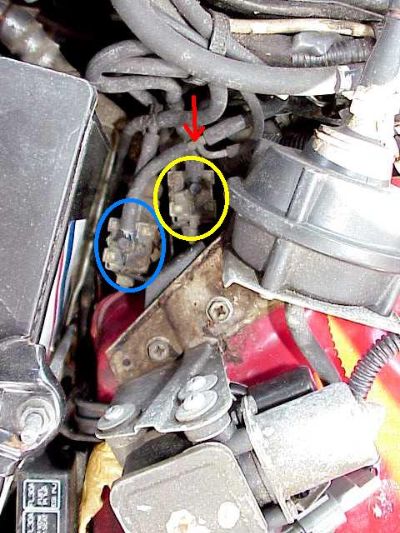 Here is the EGR solenoid circled in yellow, on the passenger side, in between the battery on the left, and the cruise control actuator on the right. The EGR solenoid is in front of an identical solenoid circled in blue, which is the AIV solenoid. The EGR solenoid is connected to the EGR in the back of the engine by a vacuum line. Here is the EGR solenoid circled in yellow, on the passenger side, in between the battery on the left, and the cruise control actuator on the right. The EGR solenoid is in front of an identical solenoid circled in blue, which is the AIV solenoid. The EGR solenoid is connected to the EGR in the back of the engine by a vacuum line.
There are three vacuum line connections and one electrical connection to the EGR solenoid. That vacuum line from the EGR solenoid to the EGR in the back of the engine should already be disconnected since the engine is preferably out of the car in order to delete the EGR. Remove the EGR solenoid mounting bracket, unbolt the EGR solenoid, unplug the electrical engine harness connection if it is still there.
The EGR shares some vacuum lines with the AIV on '90-'92 Z's. If the AIV's are still being used, then remove the T connectors and run the AIV lines directly to their source. Don't leave any open vacuum connections on the engine. Look in the Vacuum Lines section if a more detailed description of these solenoids is needed.
On an NA (normally aspirated, non-turbo) Z, the EGR solenoid is located in a different place. There's a bracket that runs from the bottom of the plenum to the exhaust manifold. The bracket is directly under the intake runner for cylinder number three, which is the middle cylinder on the passenger side. The EGR solenoid is mounted halfway up that bracket. Follow the vacuum line from the bottom of the passenger side throttle body, and it will go straight to the solenoid.
The next pic is in the back, center of the engine, with the engine out of the car. The EGR solenoid was connected by vacuum tubing to the nipple at the red arrow on the right side of the picture shown below.
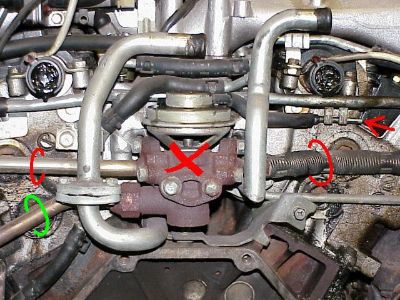 The red X is on the EGR unit. The red circles are around the metal tubes that are also part of the EGR system. These tubes wrap around the block and return exhaust gas to to the intake plenum. The red X is on the EGR unit. The red circles are around the metal tubes that are also part of the EGR system. These tubes wrap around the block and return exhaust gas to to the intake plenum.
The green circle is around the metal tube that connects the EGR to the driver side exhaust manifold.
Removing the two EGR mounting bolts can be a challenge even with the engine out of the car because of all the heat exposure. With the engine in the car, fergidaboudit.
 The circles show the 12 mm mounting bolts left in place after the EGR was removed. The arrows show the VTC solenoids, not germane to this discussion. The EGR metal tubes are gone, too. The circles show the 12 mm mounting bolts left in place after the EGR was removed. The arrows show the VTC solenoids, not germane to this discussion. The EGR metal tubes are gone, too.
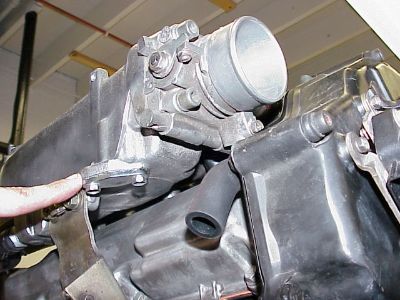 This is the passenger side where the metal tube from the EGR used to feed exhaust gas into the plenum. My finger is on the plate installed to plug the hole in the plenum. The bolts are 10mm. This is the passenger side where the metal tube from the EGR used to feed exhaust gas into the plenum. My finger is on the plate installed to plug the hole in the plenum. The bolts are 10mm.
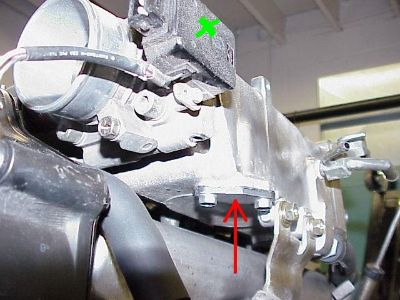 Same concept on the driver side, red arrow is pointing to the plate that was installed where the EGR metal tubes uses to feed into the plenum. Green X is on the throttle position sensor. Same concept on the driver side, red arrow is pointing to the plate that was installed where the EGR metal tubes uses to feed into the plenum. Green X is on the throttle position sensor.
A friend of mine sells the plates used to block the plenum shown above, and a plug for the driver side exhaust manifold. My aftermarket exhaust manifolds did not require an EGR plug but stock manifolds will. The AIV plugs on the same page are for a separate system.
| 